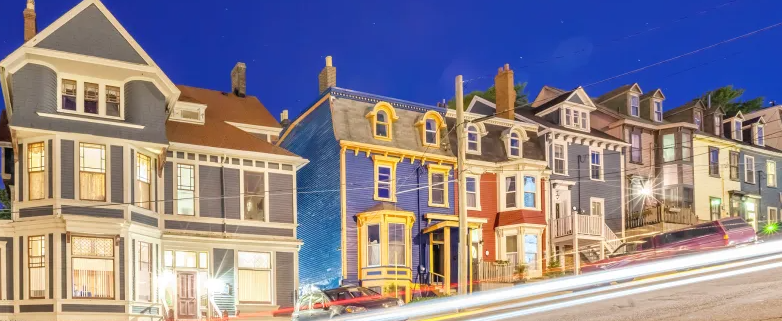
Though L’Anse aux Meadows at the northern tip of Newfoundland saw European settlers first, it was the three Maritime provinces that received the second wave to become the “downtown” of Atlantic Canada. Nova Scotia, Prince Edward Island, and New Brunswick formed a distinct region based on a sea-going economy built around fishing and shipbuilding.
While things have changed plenty over the last 500 years, the Maritimes have developed their own architectural flavour, shaped by immigration, economy, fire, and war. Like the pace of life, Maritime architecture is unique to Canada, yet as familiar and cozy as a Tim Horton’s sign on a snowy drive.

First Nations
The southern Maritimes were home to the Abenaki and Mi’kmaq nations, Algonquian-speaking, hunter-gathering peoples, about 3,000 years ago, the late period of the region’s prehistory. Their villages, usually with about 100 residents, featured oval long houses and bark-covered wigwams. These villages were sometimes fortified with palisade walls.

Nova Scotia
Heritage buildings today predominately date back to the 19th century, though areas were settled by Europeans back to the early 1600s. The deGannes-Cosby House, in Annapolis Royal is thought to be the oldest still-habitable home in Canada, tracing back to its 1708 build date. With a fieldstone foundation and wood frame, it’s typical of the French Colonial style of the period.
Looking to get the east coast style in your own home? Get inspired with our East Coast Classic design guide.
Dutch Colonial, Gothic Revival, Italianate, and Second Empire designs are seen in homes from the 1800s. Many of these, however, are hybrids. It wasn’t always common at the time to involve architects, so home designs originated with skilled carpenters instead, sometimes described as vernacular style to acknowledge the melds. Thus, a Second Empire home, already a close relative of Gothic, might see en vogue Italianate ornamentation added, perhaps at the behest of a style-conscious homeowner.

Prince Edward Island
First settled by the French as Île Saint-Jean, Prince Edward Island was part of the Acadian exodus, first as a destination for those leaving Nova Scotia, and later, expelled from the island by the British.
Through the 1800s, Prince Edward Island saw many of the same styles as in Nova Scotia, again often combining features. Wood frame construction dominated residentially, making Charlottetown vulnerable to fire. The Gainsford House is the oldest surviving brick building in the city, dating back to 1834, and it survived the fire when many of its neighbours did not. A twin-dormered double tenement in the Georgian style, Gainsford House may have started the trend away from wood construction in the area, apropos, since the owner held an interest in a local brickyard.

New Brunswick
Home to the oldest incorporated city in Canada, New Brunswick’s deepest architectural thread leads back to the American Revolution. United Empire Loyalists, remaining faithful to the British Crown, escaped along the New Brunswick side of the Bay of Fundy. At peak, they reached about 14,000 in number, and their impact is still felt in Saint John, the city that dates back to 1785.
Loyalist House in Saint John remains standing, unaltered since its 1817 construction, one of the few wood buildings to emerge intact from the Great Fire of 1877. The Merritt family built and resided in the house until 1958, when the property was converted to a museum, as it remains today. As the Merritts were Loyalists, it’s no surprise the home highlights the Federalist style prominent in New England when the family fled north.
Bruce Kuwabara has designed some of the most iconic buildings in Canada and across the globe. Read more about his work.
Otherwise, the heritage buildings of the city are predominantly brick, better suited to survive the fire, though many feature simple Federalist and Loyalist designs.

Modern architecture
The country and the world are much smaller today, and regional architecture variations may not be as pronounced as they once were. New residential construction tends to follow the same trends as seen across Canada, with the difference being the drama and natural beauty afforded by lots along the salt water shorelines shared by the three Maritime provinces.
Whether you’re looking for a traditional architectural style in the Maritimes, or want to find something more unique, a local REALTOR® can help you find the perfect home.
Courtesy: realtor.ca
Posted by Teri-Lynn Jones on
Leave A Comment